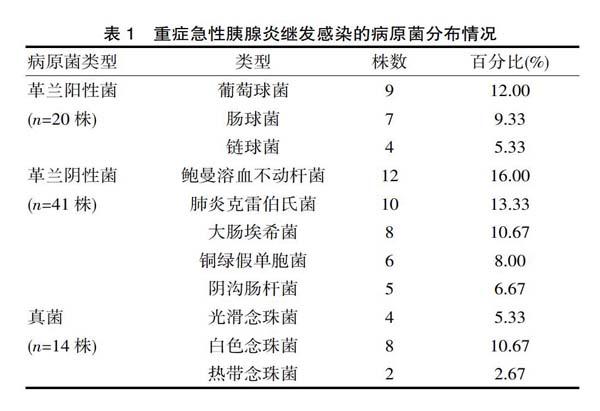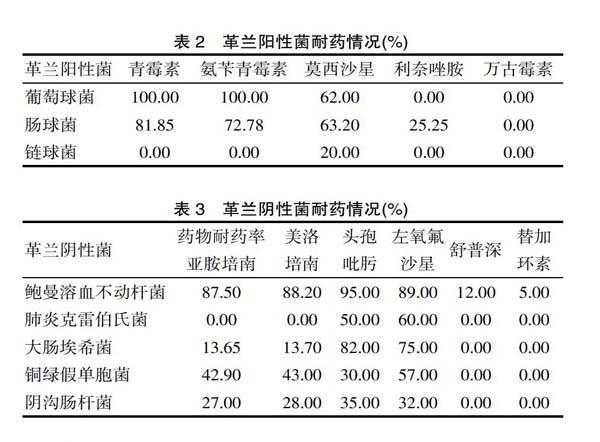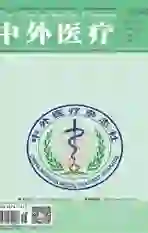重症急性胰腺炎继发感染的病原菌分布及临床特点分析
2020-09-02宋玲莉
宋玲莉


[摘要] 目的 分析重癥急性胰腺炎继发感染的病原菌分布及临床特点。方法 随机选择该院自2018年1月—2019年10月收治的70例重症急性胰腺炎继发感染患者作为研究对象,取患者气管深部痰液作为检验标本,行细菌培养,再采用全自动微生物分析系统检验其病原菌分布情况,然后,根据病原菌检出情况开展药敏试验,总结其常见致病菌的耐药情况。结果 70例患者共分离培养出75株病原菌株,其中,20株为革兰阳性菌(包含9株葡萄球菌、7株肠球菌、4株链球菌),占比26.67%,41株为革兰阴性菌(包含12株鲍曼溶血不动杆菌、10株肺炎克雷伯氏菌、8株大肠埃希菌、6株铜绿假单胞菌、5株阴沟肠杆菌),占比54.67%,14株为真菌(包含4株光滑念珠菌、8株白色念珠菌、2株热带念珠菌),占比18.67%,革兰阴性菌占比>革兰阳性菌占比>真菌占比,各类型病原菌占比对比差异有统计学意义(P<0.05);不同革兰阳性菌及革兰阴性菌的耐药率均有一定的差异,其中,革兰阳性菌对万古霉素的耐药率均较低;革兰阴性菌对舒普深、替加环素的耐药率均较低。结论 重症急性胰腺炎继发感染的病原菌以革兰阴性菌为主,且不同致病菌的耐药性具有一定差异,为提高患者抗感染治疗效果和避免其出现耐药性,就需临床尽早对患者行细菌培养检测,以明确其病原菌分布情况,再指导临床采用合理的抗菌药物对患者进行治疗。
[关键词] 重症急性胰腺炎;继发感染;病原菌分布;临床特点
[中图分类号] R446 [文献标识码] A [文章编号] 1674-0742(2020)06(a)-0196-03
Distribution and Clinical Characteristics of Pathogens Secondary to Severe Acute Pancreatitis
SONG Ling-li
Department of Gastroenterology, Xiushan County People's Hospital, Chongqing, 409900 China
[Abstract] Objective To analyze the distribution and clinical characteristics of pathogens secondary to severe acute pancreatitis. Methods A total of 70 patients with randomly severe acute pancreatitis secondary infections who were treated in the hospital from January 2018 to October 2019 were selected as the research subjects. Patients' deep trachea sputum was used as a test specimen for bacterial culture, and then fully automatic microorganisms were used. The analysis system examines the distribution of pathogenic bacteria, and then conducts drug sensitivity tests based on the detection of pathogenic bacteria to summarize the drug resistance of common pathogenic bacteria. Results A total of 75 pathogenic strains were isolated and cultured in 70 patients. Among them, 20 strains were Gram-positive bacteria (including 9 strains of Staphylococcus, 7 Enterococcus, 4 Streptococcus), accounting for 26.67%, and 41 strains were leather. Blue negative bacteria (including 12 strains of A. baumannii, 10 strains of Klebsiella pneumoniae, 8 strains of Escherichia coli, 6 strains of Pseudomonas aeruginosa, 5 strains of Enterobacter cloacae), accounting for 54.67%, 14 strains were fungi (including 4 strains of Candida glabrata, 8 strains of Candida albicans, and 2 strains of Candida tropicalis), accounting for 18.67%, Gram-negative bacteria proportion> Gram-positive bacteria proportion> Fungi proportion, each type proportion of pathogenic bacteria was statistically significant (P<0.05); the resistance rates of different Gram-positive bacteria and Gram-negative bacteria were different, and among them, the resistance rate of Gram-positive bacteria to vancomycin was higher than that of vancomycin; Gram-negative bacteria have lower resistance to Shupushen and Tigecycline. Conclusion Gram-negative bacteria are the main pathogens in secondary infection of severe acute pancreatitis, and the drug resistance of different pathogenic bacteria is different. To improve the anti-infective treatment effect and avoid drug resistance, it is necessary to clinically Bacterial culture tests should be performed on patients as early as possible to clarify the distribution of pathogenic bacteria, and then guide clinical treatment of patients with reasonable antibacterial drugs.
综上所述,重症急性胰腺炎继发感染的病原菌以革兰阴性菌为主,且不同致病菌的耐药性具有一定差异,为提高患者抗感染治疗效果和避免其出现耐药性,就需临床尽早对患者行细菌培养检测,以明确其病原菌分布情况,再指导临床采用合理的抗菌药物对患者进行治疗。
[参考文献]
[1] 殷跃文.急性胰腺炎感染者免疫状况、病原学分布及相关危险因素分析[J].中国病原生物学杂志,2019,14(8):948-951.
[2] Koutroumpakis E,Slivka A,Furlan A,et al.Man-agement and outcomes of acute pancreatitis patients over the last decade:A US tertiar-center experience[J].Pancreatology,2017,17(1):32-40.
[3] 杜奕奇,李维勤,毛恩强.中国急性胰腺炎多学科诊治(MDT)共识意见(草案)[J].中国实用内科杂 志,2015,(12):1004-1010.
[4] 周磊,刘苏来,成伟.重症急性胰腺炎继发脓毒症危险因素分析[J].实用休克杂志:中英文,2018,2(4):218-222.
[5] MA H X,HE L,CAI SW,et al.Analysis of the spectrumand resistance of pathogen causing sepsis in patients with severe acute pancreatitis[J].Zhonghua Wai Ke Za Zhi,2017,55(5):378-383.
[6] 陈文海.重症急性胰腺炎继发胰腺感染的危险因素和感染特点分析[J].河南外科學杂志,2016,22(4):19-20.
[7] 杨卫军,杜吉义,吴正阳,等.重症急性胰腺炎患者继发胰腺感染特点及危险因素分析[J].中华医院感染学杂志,2017, 27(19):4453-4456.
[8] 肖文艳,陈虎,曹利军,等.重症急性胰腺炎继发感染的病原菌分布特点[J].肝胆外科杂志,2018,26(5):348-351.
(收稿日期:2020-03-04)
